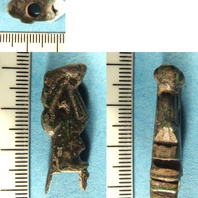
Viking Objects
Prick Spur (LIN-646C93)
Early spurs had a neck that ended in a point, called a prick, riveted to the heel band. This object is a fragment of the prick and is cylindrical in section with a terminal that divides into two arms. There is a hollow shaft above leading into two decorative crescent-shaped arms, one arching over the other. The very top of the object is pierced which suggests that something passed through the object.
Read More
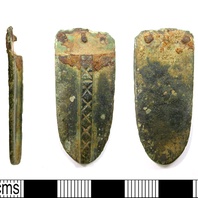
Viking Objects
Copper-Alloy Strap-End (LEIC-07ED69)
This tongue-shaped strap-end, classed as Thomas Class E Type 3, is decorated with a rectangular cross-sectioned vertical ridge running down its centre with incised ‘saltaire’ crosses.
Read More
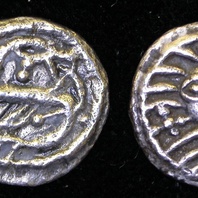
Viking Objects
Continental Sceat (LEIC-901FF1)
This silver Continental sceat is possibly part of Seaby 843 Series X which are considered to be associated with the early trading center at Ribe. It is very likely that they made their way to England by means of Vikings.
Read More
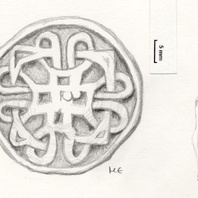
Viking Objects
Lead-Alloy Terslev Brooch (NLM-72D1C7)
This Borre-style brooch has been identified by Jane Kershaw as a Terslev Type V variant. Terslev style, where Scandinavian ring-chain patterns are the main decorative component, is a subcategory of the Borre style and takes its name from the silver hoard discovered in Terslev, Denmark. The decoration comprises a series of ring-knots related to the Borre ring-chain. The Terslev style occurs mainly on brooches and pendants, including both high-quality gold and silver jewellery as well as lower-end base metal items. The cast-base metal jewellery, such as those made of copper alloy, were intended to imitate the higher-end gold and silver jewellery, and often employed techniques such as gilding to achieve this. The Terslev designs that occur in England extend the repertoire by introducing new Scandinavian motifs hereto unrecorded in Scandinavia. For more information on Scandinavian jewellery in England check out our blog: Brooches, Pendants and Pins: Scandinavian Dress Accessories in England.
Read More
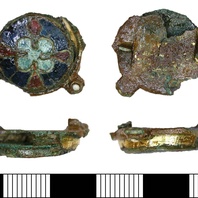
Viking Objects
Enamel Copper-Alloy Brooch (DENO-6C0D22)
This composite cast copper-alloy and enamel gilded brooch displays both Anglo-Scandinavian and Anglo-Saxon characteristics. The decorative enamel centre of the brooch was fabricated using a method known as cloisonné which involves the use of inlaid enamel cells, separated by strips of copper alloy, within an outer ring of copper alloy, all set upon a flat circular disc of copper alloy. The sides of the decorative roundel are surrounded with an upright strip of gilded copper alloy. The design of the enamel centre features a blue-green central quatrefoil, four cells which are shaped like elongated teardrops filled with red enamel giving the appearance of a cross motif, and four larger sub-rectangular cells filled with deep blue enamel. The brooch has been classified as Weetch Type 20. For more information on Scandinavian jewellery in England check out our blog: Brooches, Pendants and Pins: Scandinavian Dress Accessories in England.
Read More
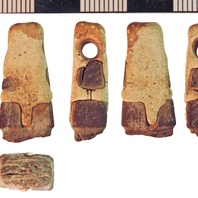
Viking Objects
Whetstone (NLM-7FA566)
Whetstone fragment, possibly made of slate that looks like ‘phyllite’, where the the broken end of the hone has been sheathed in lead, which has held its parts together. This is an unusual example of the repair of a personal hone so it could be continued to be carried and used after its breakage. The hone would originally have been of a tapered bar-shaped form and was sawn to shape. Hones of this size were personal items to be carried and worn at the belt alongside the knife they sharpened. True ‘phyllite’ hones came from Telemark in Norway, and were among the first imported whetstones of the Viking Age. A range of other banded and coloured stones, many found in graves at Birka, were adapted for similar use, and their fine appearance was as important as their usefulness as sharpening stones.
Read More
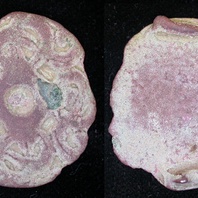
Viking Objects
Disc Brooch (LEIC-604DE5)
This example of an Anglo-Scandinavian copper-alloy disc brooch features a Borre-style knot design surrounded by a concave-sided lozenge motif. It has been classified as East Anglian Series Type I. For more information on Scandinavian jewellery in England check out our blog: Brooches, Pendants and Pins: Scandinavian Dress Accessories in England.
Read More
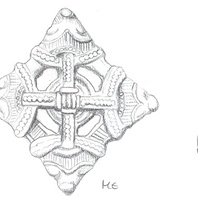
Viking Objects
Lozenge Brooch (NLM194)
This openwork Borre-style square brooch with animal heads on each corner was found in Elsham, Lincolnshire, in 1997. This type of brooch was an accessory for women wearing Scandinavian dress. For more information on Scandinavian jewellery in England check out our blog: Brooches, Pendants and Pins: Scandinavian Dress Accessories in England.
Read More
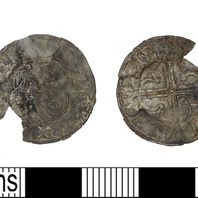
Viking Objects
Coin of Cnut the Great (LEIC-B1F8EA)
This coin is an example of a Quatrefoil type silver penny of Cnut, minted in Stamford or Norwich by the moneyer Thurstan. Minting coins was a way of controlling the means of exchange within a kingdom and one which created a more easily administered standardized system of trade. Moreover, the coins themselves were often used as propaganda, portraying symbols and statements that gave off a desired message. The Vikings later used the minting of coins to legitimise their own rule.
Read More
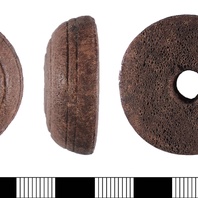
Viking Objects
Bone Spindle Whorl (LIN-9D24C2)
Fibres were spun into thread using a drop-spindle of which the whorls were made of bone, ceramic, lead, or stone and acted as flywheels during spinning. Other bone and ceramic spindle whorls with decorative circumference grooves are known from Anglo-Saxon sites elsewhere in areas such as West Stow, Suffolk.
Read More
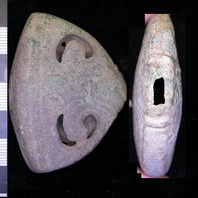
Viking Objects
Sword Pommel (LEIC-9158C3)
The pommel is probably a late development of Petersen’s type X which encompases transitional to medieval forms. Copper-alloy pommels with this basic shape are rare but not unknown in Viking Age Europe with a reasonably close example from Lough Derg, County Tipperary, in the National Museum of Ireland. The symmetrical Ringerike-style engraving is very similar to decoration commonly found on stirrup-strap mounts of the eleventh century.
